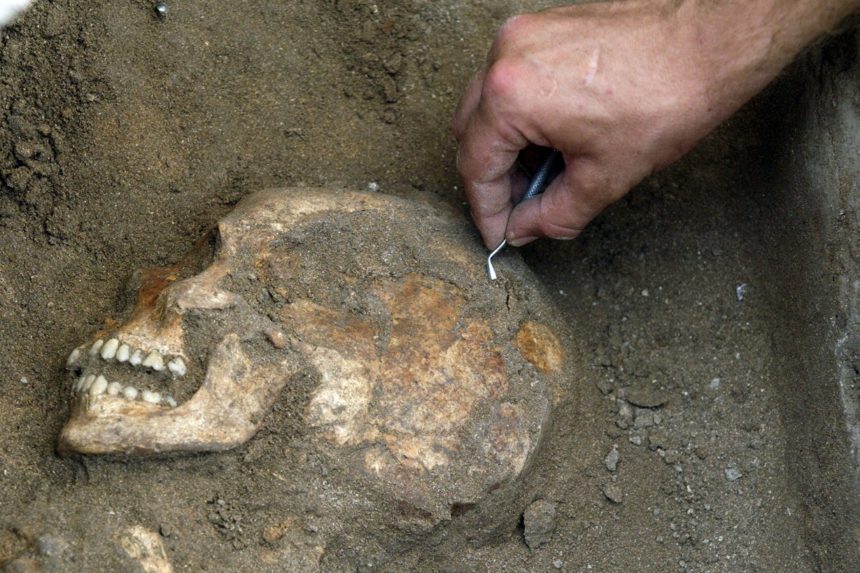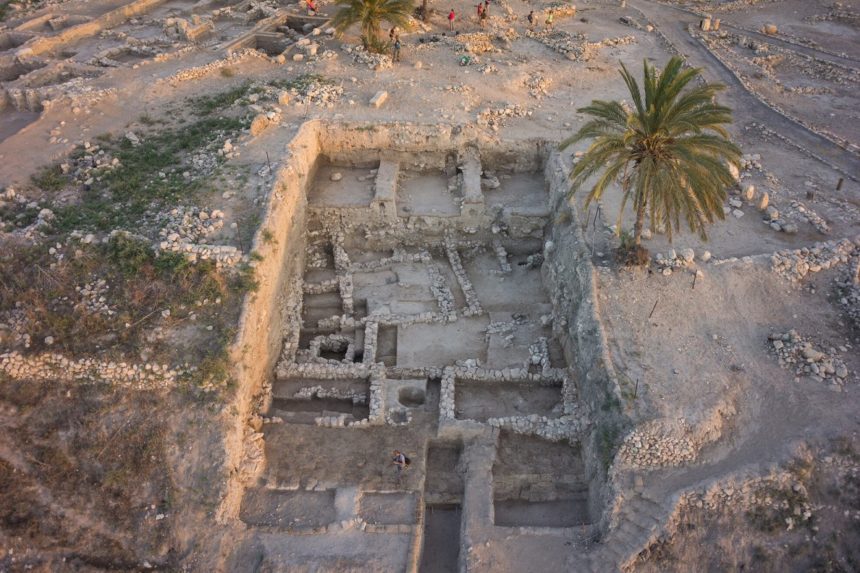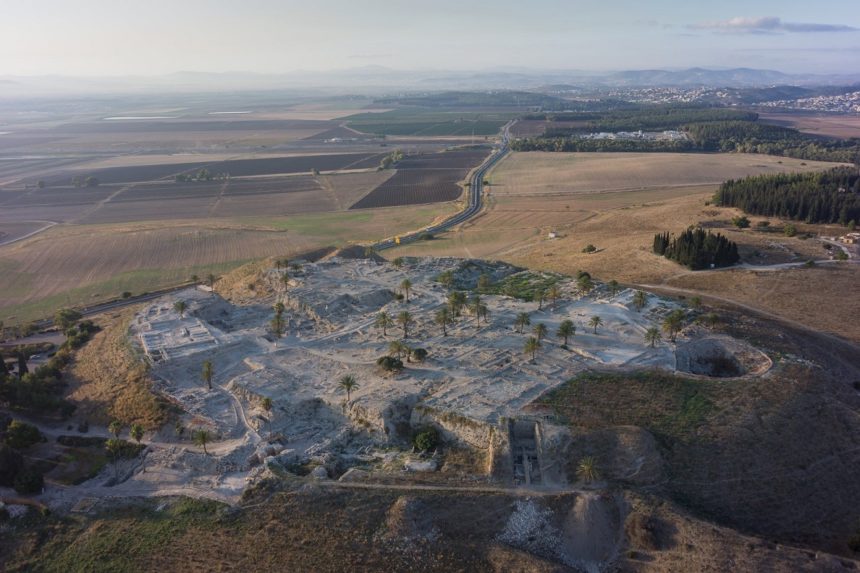Most of today’s Jewish and Arabic-speaking populations share a strong genetic link to the ancient Canaanites, a study by an international team of archaeologists and geneticists has found. These modern-day groups in Israel, Jordan, Lebanon, and parts of Syria share a large part of their ancestry, in most cases more than half, with the people who lived in the Levant during the Bronze Age more than 3,000 years ago, the study concludes.
The researchers also determined that the Canaanites – who frequently appear in ancient sources, including the Bible – descended from a mixture of an earlier Levantine population and migrants coming from the Caucasus region or northwestern Iran.
In the wide-ranging study published Thursday in the journal Cell, experts analyzed genetic material from dozens of skeletons found at Canaanite sites across Israel and neighboring countries, and compared it to the genomes of other ancient populations as well as to modern-day groups.
“This study suggests there is a deep genetic connection of many Jewish groups today across the Diaspora and many Arab groups to this part of the world thousands of years ago,” says David Reich, a Harvard University geneticist and one of the world’s top experts in the study of ancient DNA.
Biblical hyperbole
The land of Canaan and its inhabitants are mentioned in documents from the 2nd millennium B.C.E., such as the Amarna letters, an archive of ancient Egyptian correspondence between the pharaohs and their colonial empire in the Levant. The Bible describes the Canaanites as the inhabitants of the Holy Land before the Israelites conquered it following their exodus from Egypt.
The holy text also claims that the arriving Israelites “destroyed all that breathed” (Joshua 10:40) and exterminated the Canaanites during the conquest of land.
This is not borne out by most archaeological and biblical scholarship over the last decades, which suggests that the story of the conquest, like most of the Bible, was written much later than the events it purports to relate.
As archaeologist Ann Killebrew wrote in her 2005 book, Biblical Peoples and Ethnicity: “Almost without exception, scholars agree that the account in Joshua holds little historical value vis-à-vis early Israel.”
Instead, it now seems more likely that between the end of the Bronze Age and the early Iron Age (that is, just over 3000 years ago), Canaanite culture slowly evolved and morphed into that of the various peoples that are familiar to any reader of the Bible: the Israelites, the Moabites, the Ammonites and so on. (One partial exception to this model would be the Philistines, who appear to have had at least some southern European ancestry.)
The new genetic study provides powerful backing to this idea of continuity, though the researchers caution that we don’t yet have enough ancient DNA samples from later eras, especially the Iron Age, to trace a direct line between the Canaanites and today’s Middle Eastern populations. There may yet be another, unsampled population from the Levant that has a more direct link to Jews and Arabs today, qualifies Liran Carmel, a computational biologist from the Hebrew University in Jerusalem and one of the lead authors of the study.

Canaanite descendants in Saudi Arabia and Iran
Still, the genetic commonalities between modern Levantine groups and their Canaanite predecessors are strong. During the course of the four-year-long study, the researchers analyzed the genome of 93 people who lived roughly between 2500 B.C.E. and 1000 B.C.E. and whose remains were uncovered in Israel, Lebanon and Jordan.
They then compared the genetic material to samples from 17 modern populations, including European – or Ashkenazi – Jews, Palestinians and other Middle Eastern groups.
In most of these, the percentage of ancestry matching that of the Bronze Age samples was above 50 percent.
Saudi Arabians, Bedouins and Iranian Jews had the highest ratio, hovering around 90 percent. These were followed by Palestinians, Jordanians and Syrians, with an 80 percent of ancestry shared with the ancient Levantines. Moroccan and Ashkenazi Jews had a roughly 70 and 60 percent contribution.
Somewhat unsurprisingly, most of the rest of the ancestry of Ashkenazi Jews comes from Europe. The lowest percentages of Middle Eastern ancestry were found in modern-day Moroccans (40 percent), and 20 percent for Ethiopian Jews, who have a strong contribution from Eastern African ancestry.
To varying degrees, all the groups displayed a strong connection to a common ancestor population in the Near East, while also showing that since the Bronze Age they have had contact with many other groups from different parts of the world, Carmel explains.
The overarching goal of ancient DNA research is to trace the story of human dispersal, migration and admixture rather than highlight major genetic differences between human populations.
Most humans today share about 99.9 percent of their DNA with each other, but with 3.2 billion base pairs in the human genome there are still plenty of genetic sequences that can display variability, Carmel explains. Some of these sequences, often non-functional sections of our DNA, can be identified as typical of a certain area or group, particularly if the local population has been relatively isolated for a long time. Researchers can then use these telltale markers of origin to build statistical models that show how much of our ancestry comes from one comparison group or another.
This is what was done twofold in the case of the research published in Cell, not only by comparing the Canaanite DNA to that of modern Jews and Arabs, but also by trying to model the relationship between the Bronze Age inhabitants of the Holy Land and even older populations.

Whence the Canaanites?
Actually the main goal of this study, titled “The Genomic History of the Bronze Age Southern Levant,” was to determine the origins of the Canaanites and whether they could be described as a genetically coherent group, distinct from their neighbors, says Reich, the Harvard geneticist.
We know that the Canaanites were divided into various independent city states, many of them powerful in their own right, such as Megiddo, Hazor, Acre and so on. Plus, most of the texts about them come from outside or later sources. So there has been some question among researchers as to whether we should even be speaking about a “Canaanite people” and whether this nomenclature is not a later, artificial construct, Reich says.
The new study shows that genetically at least, the Canaanites did have a lot in common with each other. Most of the recovered genomes, from Sidon in Lebanon through Megiddo in the Jezreel Valley and down to Ashkelon in southern Israel, could be modeled as having a roughly 50/50 contribution of ancestry from local Neolithic inhabitants and from a group that hailed from the Caucasus or the Northwestern Zagros mountains, in today’s Iran.
Researchers have known for a while that there were large influxes of people into the southern Levant over the last millennia of prehistory. For example, a previous ancient DNA study found that a Copper Age culture centered near the modern-day Galilean village of Peki’in emerged from the admixture of a local population with Anatolian and Iranian newcomers.
In the case of the Canaanites, it is more likely that the population influx came from the Caucasus, rather than Iran, because we do have evidence of a cultural link between the Caucasus and the southern Levant in the Bronze Age, says Israel Finkelstein, a Tel Aviv University archaeologist who took part in the study.
This connection is particularly clear at Khirbeth Kerak (Beit Yerah), a site on the southern shore of the Sea of Galilee dated to the first half of the 3rd millenium B.C.E. There, archaeologists found pottery vessels – typified with the name Khirbeth Kerak Ware – which bear strong similarities to the ceramics produced by the Kura-Araxes culture, a civilization that spanned the Caucasus region in the Early Bronze Age.
“This type of pottery is very clearly influenced by this northern culture, and the question is whether the influence was by contact, such as trade or exchange of knowledge, or people moving,” Finkelstein says. “Now we have evidence that it was people moving.”
Further bolstering the theory of Caucasian admixture, Finkelstein notes, is the fact that the names of some Canaanite rulers mentioned in the 14th century-B.C.E. Amarna documents from Egypt are not Semitic in origin but Hurrian, a language then spoken in northern Syria and eastern Anatolia.

Waves of migration
For the ancestry of the Canaanites to be split halfway between locals and newcomers there would have had to be an influx of a significant number of people; and a question that begs to be asked is whether this inflow was an invasion or a peaceful migration.
While we cannot be sure of its nature, it is likely that this phenomenon occurred over a long period of time, perhaps centuries, says Carmel, the bioinformatics expert. This is based on the fact that the percentage of Caucasian/Iranian descent tends to be lower in the older samples in the dataset and increases with time, he says.
“I don’t think we are dealing with an invasion,” Finkelstein adds. “We have no archaeological evidence of destruction or a major disruption in the Early Bronze Age.”
There is evidence that the waves of migration continued for centuries, at least until the beginning of the Late Bronze Age. Three individuals unearthed at Megiddo and dated to the 16th-15th centuries B.C.E. were found to have a much larger percentage of Caucasian ancestry, with only around 20 percent of their genome deriving from the local Neolithic population. This means that these three were likely descendants of people who had arrived from the Caucasus relatively recently, just a few generations earlier.
The next step for researchers will be to continue modeling the ancient populations of the Levant, especially after the time of the Canaanites, Finkelstein says; “It will be interesting to see what happened afterward, what was the genetic profile of the people of biblical Israel and Judah, how do they connect to us and to their predecessors, and what were the other contributions to the genetic pool along the way.”


